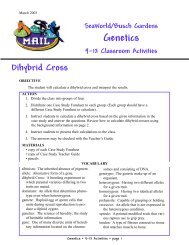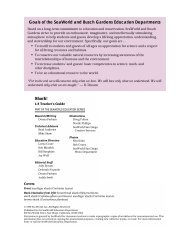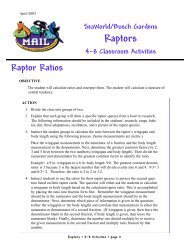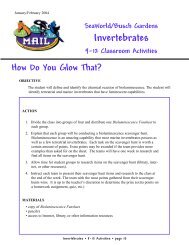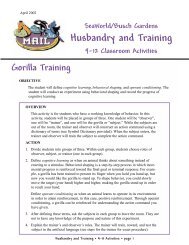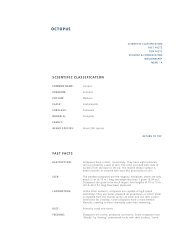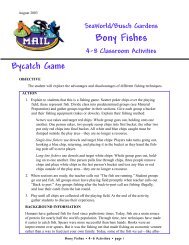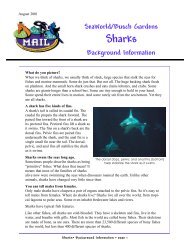You also want an ePaper? Increase the reach of your titles
YUMPU automatically turns print PDFs into web optimized ePapers that Google loves.
<strong>CHITONS</strong><br />
SCIENTIFIC CLASSIFICATION<br />
COMMON NAME: chitons<br />
KINGDOM: Animalia<br />
PHYLUM: Mollusca<br />
CLASS: Polyplacophora<br />
ORDER: Order: Neoloricata<br />
3 Suborders:<br />
• Lepidopleurida<br />
• Ischnochitonida<br />
• Acanthochitonida<br />
FAMILY:<br />
GENUS SPECIES: About 1,000 species<br />
FAST FACTS<br />
SCIENTIFIC CLASSIFICATION<br />
FAST FACTS<br />
FUN FACTS<br />
ECOLOGY & CONSERVATION<br />
BIBLIOGRAPHY<br />
MENU - A<br />
RETURN TO TOP<br />
DESCRIPTION: Chitons are flat, elongated molluscs with a broad foot and eight<br />
overlapping, dorsal shell plates. The mantle forms a thick girdle<br />
that either borders or covers the shell plates. The girdle may be<br />
smooth or have scales, bristles, or calcareous spicules. Without<br />
eyes or tentacles, the head is indistinct. Chitons are generally dull<br />
shades of red, brown, yellow, or green.<br />
SIZE: 3 mm to 40 cm (0.12–15.7 in.); Most species average 3 to 12 cm<br />
(1.18–4.72 in.).The largest chiton is the gumboot chiton,<br />
Cryptochiton stellari.<br />
LOCOMOTION: The broad, muscular foot is used for adhesion and locomotion.<br />
Chitons can creep very slowly by muscular waves in the foot, the<br />
same way as snails. If dislodged, chitons have the ability to roll up<br />
into a ball.<br />
DIET: Fine algae and small organisms
FEEDING: Food is scraped from the surface of rocks and shells with a radula.<br />
REPRODUCTION: Chitons are either male or female. Males release sperm and<br />
fertilization takes place in the water or within the mantle cavity of<br />
the females. Eggs are either shed into the sea or brooded within<br />
the mantle cavity of the females.<br />
RESPIRATION: Six to 88 pairs of bipectinate gills are used for gas exchange. The<br />
number of gills varies among species and within a species<br />
depending on size.<br />
LIFE SPAN: About 20 years<br />
RANGE: Oceans worldwide; most common in temperate rocky shores<br />
HABITAT: Intertidal to deep sea; common in rocky intertidal habitats.<br />
FUN FACTS<br />
RETURN TO TOP<br />
1. Many chitons have “homing sites,” which they return to after nocturnal feeding or<br />
feeding during a high tide.<br />
2. Many of the chiton species that inhabit the Pacific west coast are light-sensitive and<br />
are found underneath rocks, carefully protected from the sun.<br />
3. A predatory chiton, Placiphorella velata, captures worms or small crustaceans, unlike<br />
other grazing chitons. It clamps down on these larger prey items with a large<br />
extension of the mantle, referred to as the “head flap.” While waiting for prey, it lifts it<br />
front end and supports itself on tentacles fringing the mantle folds.<br />
4. For more information, please visit the Tide Pool Infobook.<br />
ECOLOGY AND CONSERVATION<br />
RETURN TO TOP<br />
Beachcombers, tidepoolers, and divers must remember not to disturb or collect any<br />
specimens that they may encounter. The removal of animals from an ecosystem may disrupt<br />
ecological processes and decrease the diversity in areas that are frequently visited. Because<br />
of their specific nutritional and physiological needs, certain animals, such as chitons have a<br />
much better chance for survival in their natural environment than in an unregulated home<br />
aquarium.<br />
BIBLIOGRAPHY<br />
RETURN TO TOP
Buchsbaum, M. R. a. P., Vicki & John. (1987). Living Invertebrates. Pacific Grove, CA, The<br />
Boxwood Press.<br />
Morris, R. H., D. p. Abbott, et al. (1980). Intertidal Invertebrates of California. Stanford,<br />
Stanford University Press.<br />
Myers, P., R. Espinosa, C. S. Parr, T. Jones, G. S. Hammond, and T. A. Dewey. 2006. The<br />
Animal Diversity Web (online) <br />
Ruppert, E. E. and R. D. Barnes (1994). Invertebrate Zoology. San Diego, Harcourt Brace<br />
College Publishers.<br />
RETURN TO TOP<br />
RETURN TO PREVIOUS PAGE






